Have you been suffering from persistent pain and limited arm mobility? If so, you may be suffering from a Distal Biceps Tendon injury. These injuries can significantly impact your ability to perform everyday activities, making it essential to seek timely and expert medical attention. At the Sydney Orthopaedic Surgeon Clinic, we understand the challenges you may be facing, and we are here to help.
Leading the way in providing exceptional care is Dr Stuart Kirkham, a highly skilled and experienced orthopaedic surgeon. With more than 25 years of valuable experience in treating a wide range of orthopaedic conditions, Dr Kirkham has become a trusted name in the field. His expertise and dedication to patient care have earned him a reputation for delivering personalised treatment plans tailored to each individual’s needs.
At the Sydney Orthopaedic Surgeon Clinic, we offer comprehensive diagnosis and treatment options for Distal Biceps Tendon injuries, and Dr Kirkham is always ready to provide you with the expert care you deserve. From non-surgical treatments such as physiotherapy and medication to advanced surgical interventions, he has the expertise to address your specific condition effectively.
Don’t let pain and limited mobility hold you back any longer. Reach out to our friendly team and schedule a consultation with Dr Kirkham. Together, you’ll develop an individualised treatment plan to get you back to doing the things you love and living life to the fullest.
Anatomy
The bicep muscle, located in the front of the upper arm, is a vital component of our arm’s strength and mobility. Comprised of two heads, with one long and one short, the biceps muscle extends from the shoulder joint down to the elbow joint. It is responsible for flexing the elbow joint, allowing us to perform movements such as lifting and bending our arms.
One essential structure within the biceps muscle is the Distal Biceps Tendon. This tendon attaches the biceps muscle to the radius bone in the forearm, playing a crucial role in arm mobility and stability. The Distal Biceps Tendon allows us to perform actions like twisting our forearm, rotating the palm upward or downward, and maintaining a strong grip. Without a properly functioning Distal Biceps Tendon, these movements become challenging and can significantly impact our ability to perform everyday tasks.
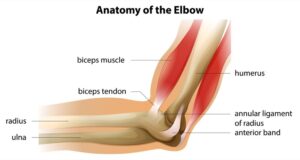
The Distal Biceps Tendon also works with other joints and muscles, such as the shoulder joint, to allow for coordinated movement of the arm. It also interacts with other muscles in the forearm, such as the brachialis and brachioradialis, to enhance grip strength and forearm stability.
Injuries to the Distal Biceps Tendon can occur as a result of several different causes, including sudden trauma, repetitive strain, or degenerative changes. When the tendon becomes damaged or ruptured, it can result in pain, weakness, and a noticeable bulge in the arm. These symptoms can significantly impact our ability to perform daily activities and require prompt medical attention.
Understanding the intricate anatomy of the biceps muscle and the crucial role of the Distal Biceps Tendon provides insight into the importance of addressing any injuries or issues affecting this structure. With the expertise of Dr Kirkham at the Sydney Orthopaedic Surgeon Clinic, you can receive a comprehensive evaluation, accurate diagnosis, and effective treatment options tailored to your specific condition. Don’t let a Distal Biceps Tendon injury limit your arm mobility and functionality – seek professional care and get back to living life to the fullest.
Causes and Risk Factors
Distal Biceps Tendon injuries can occur as a result of many different activities or movements that put stress on the tendon. Sudden and forceful motions, such as lifting heavy objects, especially with an extended arm, can increase the risk of injury. Activities that involve repetitive or prolonged gripping, such as weightlifting, rock climbing, or certain sports like wrestling or martial arts, can also contribute to the development of Distal Biceps Tendon injuries. To avoid overexertion and minimise the risk of injury, it’s important to be mindful of proper lifting techniques when undertaking these activities.
While Distal Biceps Tendon injuries can affect individuals of any age, certain age groups may be more prone to these injuries. Middle-aged and older adults, typically between the ages of 30 and 60, are at a higher risk due to age-related changes in the tendon’s strength and flexibility. Individuals employed in physically demanding occupations or activities that require repetitive arm motions, such as construction workers or professional athletes, may also face an increased risk of Distal Biceps Tendon injuries.
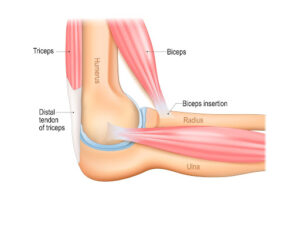
The overall health and fitness level of an individual can also play a role in the risk of this type of injury. Poor overall health, including conditions like obesity or diabetes, can weaken the tendon and make it more susceptible to injury. Additionally, inadequate conditioning and insufficient strength training of the arm muscles can contribute to an increased risk. It’s important to maintain a balanced exercise routine that includes strength training exercises targeting the arms and shoulders to help prevent Distal Biceps Tendon injuries.
By adopting proper lifting techniques, avoiding repetitive strain, and maintaining overall fitness and strength, individuals can minimise the likelihood of experiencing a Distal Biceps Tendon injury. If you’d like to find out more about how you can prevent these injuries from occurring, Dr Kirkham can be of assistance. His extensive experience and expertise in orthopaedic care allow him to offer personalised guidance and recommendations to help individuals mitigate the risk factors associated with Distal Biceps Tendon injuries. However, if you believe you’ve suffered this injury, you may also reach out to Dr Kirkham. With his early intervention and tailored treatment plans, you’ll be better able to prevent further damage and alleviate symptoms.
Symptoms and Identification
Distal Biceps Tendon injuries can result in a range of symptoms that significantly impact the patient’s daily life. The most common symptom associated with these injuries is persistent pain that is localised to the front of the elbow or the upper forearm. The pain may worsen with certain activities or movements that involve bending the elbow or rotating the forearm. Weakness in the affected arm is another common symptom, and this can make it more difficult for the individual to perform tasks that require grip strength or lifting objects. Individuals may also experience a limited range of motion in the affected arm, making it challenging to fully extend or flex the elbow joint.
Identifying these symptoms yourself can help prompt timely medical attention. If you have experienced an injury or trauma to the elbow or forearm and subsequently notice pain, weakness, or limited mobility, it is important to be mindful of the possibility of a Distal Biceps Tendon injury. Pay attention to the location of the pain and observe if it worsens or improves with specific movements. If you are unable to perform activities that previously posed no challenge, or if you notice a visible bulge in the upper forearm, these could be additional indicators of a Distal Biceps Tendon injury.
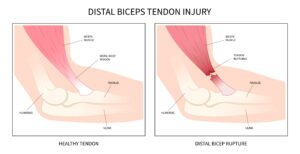
Certain warning signs should prompt a visit to a healthcare professional. If the pain is severe and unrelenting, or if you have difficulty using the affected arm for routine tasks, it is crucial to seek medical attention promptly. Additionally, if you experience a sudden “pop” or tearing sensation at the elbow accompanied by immediate pain and weakness, it is recommended to consult a healthcare professional without delay. These warning signs could indicate a significant injury to the Distal Biceps Tendon that may require immediate evaluation and treatment.
If you believe you have suffered this injury, don’t hesitate to contact Dr Kirkham from the Sydney Orthopaedic Surgeon Clinic. He has provided individualised and highly effective treatment options for a range of different Distal Biceps Tendon injuries for more than 25 years and secured many pleasing results. With his vast medical expertise, personalised advice, and tailored treatment plans, you’ll be well on your way to eliminating your pain and improving your quality of life.
Diagnosis and Imaging
Diagnosing a Distal Biceps Tendon injury involves a comprehensive evaluation of the patient’s symptoms, medical history, and a thorough physical examination.

During the initial consultation, Dr Kirkham will listen to your concerns and gather relevant information about your symptoms, including the onset, duration, and any specific activities that may have triggered or exacerbated the pain and weakness. He will also take into account any pre-existing conditions or risk factors that may impact the treatment plan.
A thorough physical examination is essential in assessing the range of motion, strength, and stability of the affected arm. Dr Kirkham will carefully examine the elbow and forearm, checking for signs of swelling, bruising, or a visible deformity. Specific tests, such as the Hook Test or the Biceps Squeeze Test, may be performed to further evaluate the integrity of the Distal Biceps Tendon.
Imaging tests also play a vital role in confirming the diagnosis and providing detailed information about the extent of the injury. Tests such as magnetic resonance imaging (MRI) and ultrasound are commonly used to assess the integrity of the Distal Biceps Tendon.
They may also reveal abnormalities, tears, or other structural changes in the tendon, helping to guide treatment decisions. MRI assesses the soft tissues to determine the location and severity of the injury, while Ultrasound offers real-time imaging to assess dynamic movements of the tendon during certain activities.
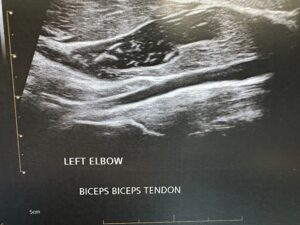
If you’re concerned that you have been experiencing the symptoms of a Distal Biceps Tendon injury, or if you have a family history of these conditions, it’s crucial to seek expert medical advice for a thorough diagnosis. Dr Kirkham has extensive experience in diagnosing and treating Distal Biceps Tendon injuries, and by seeking his assistance, you can set yourself on the road to recovery. Don’t hesitate to contact Dr Kirkham for a thorough consultation and diagnosis today.
Treatment Options
Treatment options for Distal Biceps Tendon injuries can vary depending on the severity of the injury, individual factors, and the patient’s goals. Non-surgical approaches are typically considered the initial course of treatment, and they often include physiotherapy, medication, and lifestyle adjustments.
Physiotherapy plays a crucial role in the rehabilitation process by providing the individual with specific exercises and techniques aimed at improving their range of motion, strength, and overall function of the affected arm. They may conduct ultrasounds, heat or cold therapy, and use manual techniques to alleviate pain and promote healing.

Nonsteroidal anti-inflammatory drugs (NSAIDs) may also be recommended to manage pain and reduce inflammation associated with the injury. These medications can help improve comfort and support the rehabilitation process. Lifestyle changes, such as modifying activities or avoiding certain movements that may strain the injured tendon, can also assist the healing process and prevent further damage from occurring.
In some cases, surgical intervention may be necessary to repair a severely damaged or completely ruptured Distal Biceps Tendon. Surgical treatment options may include tendon reattachment, either through an open procedure or a minimally invasive technique known as endoscopic repair. Dr Kirkham’s surgical approach is highly effective and generally takes 45-60 minutes, offering the patient a smooth process with expert guidance based on the individual patient’s condition and goals.
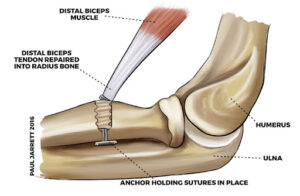
Whether it is through non-surgical treatment options, surgical intervention, or a combination of approaches, Dr Kirkham aims to provide personalised care to optimise outcomes. He works closely with patients to develop a treatment plan tailored to their specific needs while ensuring each of his patients receives the highest level of care throughout their treatment journey. The goal is to restore function, reduce pain, and help patients enjoy an improved quality of life.
Prevention and Aftercare
While Distal Biceps Tendon injuries can be inevitable, there are proactive steps that can be taken to minimise the risk of injury and maintain the health and function of the arm.
First and foremost, it is important to engage in regular strength training exercises that target the muscles in the arms and shoulders. This helps to improve the overall strength and stability of the tendons and muscles surrounding the Distal Biceps Tendon. Additionally, maintaining proper form during activities and exercises is essential. This includes using correct lifting techniques, avoiding excessive strain on the tendons, and maintaining proper posture.
Another important aspect of prevention is ensuring the use of appropriate equipment. When engaging in activities that involve repetitive arm movements or heavy lifting, it is essential to use equipment that provides adequate support and protection. This may include wearing supportive braces when bouts of pain arise or using ergonomic tools that minimise strain on the tendons.
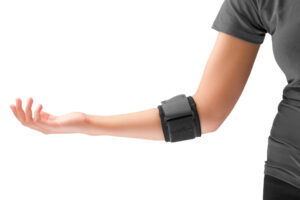
Aftercare is also central to the recovery process following a Distal Biceps Tendon injury. Once a patient has undergone treatment, a structured rehabilitation program with physiotherapy and home exercises is helpful. Physiotherapy sessions are designed to gradually restore strength, flexibility, and range of motion in the affected arm, and guide patients through specific exercises and techniques that target that strengthen the injured tendon and surrounding muscles. These exercises help to improve muscle balance, reduce scar tissue formation, and enhance overall function.
Self-directed home exercises and self-care are also crucial to the aftercare process. Patients are usually provided with a tailored exercise program to be performed at home, which helps to reinforce the gains made during physiotherapy sessions. These exercises are designed to gradually progress and promote the healing and strengthening of the tendon. It is important for patients to follow the prescribed exercise program diligently and report any concerns or difficulties to their healthcare team.

By implementing practical prevention strategies, maintaining proper form and equipment, and diligently following the aftercare process, individuals can significantly reduce the risk of Distal Biceps Tendon injuries and promote optimal recovery when the injury does occur.
The Recovery Process
The recovery process following a Distal Biceps Tendon injury can vary depending on several factors, including the severity of the injury, the chosen treatment approach, and individual factors such as overall health and adherence to rehabilitation protocols. While every recovery is unique, a general timeline can provide an idea of what to expect.
In the initial stages, the focus is on allowing the injured tendon to heal. This typically involves a period of rest and immobilisation, which may last several weeks. Managing pain and discomfort during the recovery process is essential in these initial stages, and pain medication, as prescribed by the healthcare provider, may aid this process. Applying ice packs to the affected area can help reduce inflammation and provide relief, while gentle stretching and regular breaks from activity can also help manage pain and prevent excessive strain on the healing tendon.

Regular follow-ups with the healthcare provider are crucial throughout the recovery process, as they allow for close monitoring of the healing and range of motion, and necessary adjustments to the rehabilitation plan can be made. The frequency of follow-ups will depend on individual circumstances and the treatment protocol. These regular appointments are fantastic opportunities for the patient to address any concerns or questions and ensure that the recovery is on track.
It is important to note that the recovery process may be influenced by various factors. These can include the patient’s age, overall health, commitment to rehabilitation protocols, and adherence to the advice and instructions provided by the healthcare team. Each individual’s recovery journey is unique, and it is essential to have realistic expectations and follow the guidance of Dr Kirkham to achieve the best possible outcome.

By understanding the timeline for recovery, managing pain and discomfort effectively, and maintaining regular follow-up appointments, individuals can navigate the recovery process with confidence and work towards regaining optimal function and strength in the affected arm.
Possible Complications
While each of the various treatments for Distal Biceps Tendon injuries is generally very safe and effective, there is always a small risk that complications may arise during or after treatment. It is important to be aware of these potential complications and understand how they can be managed or mitigated.
Complications that may occur during treatment include infection, bleeding, or nerve injury. Any type of surgical procedure carries a small risk of infection, but you can take comfort in the knowledge that Dr Kikrham has 25 years of experience conducting these surgeries. Aside from his experience and expertise, he actively works to reduce these risks by adhering to strict sterilisation techniques and taking every precaution possible in all procedures.
Bleeding is another potential complication, but this is also managed carefully by proper surgical techniques and monitoring. While rare, nerve injuries may also occur, but to mitigate this risk, Dr Kirkham ensures he takes great care to identify and protect the nerves around the elbow.
After treatment, complications such as stiffness, loss of strength, or re-rupture of the tendon can occur. Stiffness can be managed through physiotherapy and appropriate stretching exercises to improve the range of motion, while loss of strength can be managed by progressive resistance exercises and targeted rehabilitation protocols. Re-rupture of the tendon is a potential complication, particularly in cases where the tendon has been surgically repaired. To minimise the risk of re-rupture, it’s important to stick closely to all post-operative protocols and rehabilitation plans provided by Dr Kirkham and avoid excessive strain during the healing phase.
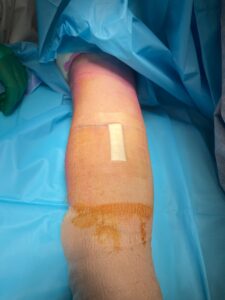
Other steps you should take to avoid complications include adhering to any prescribed medication regimens, attending follow-up appointments with Dr Kirkham, and participating in the recommended rehabilitation program. Post-operative and aftercare advice is always crucial to ensure a smooth healing process and optimal recovery from Distal Bicep Tendon injuries.
However, if you do have concerns or experience complications during your treatment or recovery process, be sure to inform Dr Kirkham. By maintaining open and regular communication, Dr Kirkham will be able to minimise any ill effects and help you achieve a successful outcome.
Are You Concerned about A Distal Biceps Tendon Injury?
Have you been suffering from persistent elbow pain or discomfort? It is important to take these symptoms seriously and closely monitor them as they may indicate a potential Distal Biceps Tendon injury. Seeking medical advice is essential for an accurate diagnosis and appropriate treatment. Don’t let the pain or limited mobility hold you back from enjoying your everyday activities.
Fortunately, Dr Stuart Kirkham from the Sydney Orthopaedic Surgeon Clinics specialises in the diagnosis and treatment of Distal Biceps Tendon injuries. When you rely on his expertise and personalised approach, you’ll receive all the guidance and care you need to recover and regain the proper function of your arm.
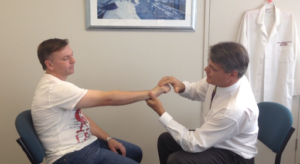
Don’t hesitate to reach out and schedule a consultation with Dr Kirkham. During the consultation, he will carefully assess your condition, discuss your symptoms and medical history, and develop a tailored treatment plan that’s designed to help you achieve your specific objective. Whether you require non-surgical options like physiotherapy and medication or specialised surgical intervention, Dr Kirkham can provide the expert medical support you needed to help you on your road to recovery.
Frequently Asked Questions
1. How long does it take to recover from a distal biceps tendon injury?
The recovery time for a distal biceps tendon injury can vary depending on the severity of the injury, the chosen treatment approach, and individual factors like the patient’s age. Generally, it can take anywhere from several weeks to months for the tendon to heal and for strength and function to be restored. Following a thorough evaluation by Dr Kirkham, you’ll receive a more accurate estimate of the recovery timeline based on your specific situation.
2. Can a distal biceps tendon injury heal without surgery?
In some cases, non-surgical treatment options may be sufficient to address a distal biceps tendon injury. Non-surgical approaches such as physiotherapy, medication, and lifestyle modifications can help alleviate symptoms, improve strength, and restore functionality. However, the choice of treatment depends on factors such as the extent of the injury, individual needs and goals, and the recommendation of the healthcare professional.
3. Can a distal biceps tendon injury recur after treatment?
While the risk of recurrence is generally low, there is a possibility of re-injury or re-rupture of the distal biceps tendon. It is crucial to follow the recommended rehabilitation program, adhere to post-treatment instructions, and engage in proper strengthening exercises to minimise the risk of recurrence. Maintaining overall arm strength, proper form during activities, and avoiding overexertion can also help reduce the likelihood of re-injury. However, it’s important to note that recurrence of the injury is rare and Dr Kirkham provides personalised rehabilitation programs to help each of his patients experience a smooth recovery.
4. Can a distal biceps tendon injury lead to long-term complications?
When properly treated and rehabilitated, many individuals with distal biceps tendon injuries can achieve full recovery without any long-term complications. However, in some cases, complications such as residual weakness, limited range of motion, or stiffness may occur. These complications can often be managed through continued physiotherapy, targeted exercises, and modifications to daily activities. Regular follow-ups with Dr Kirkham can help identify and address any potential issues to prevent any long-term complications from developing.
5. Can I prevent a distal biceps tendon injury through exercise?
While it may not be possible to completely prevent all distal biceps tendon injuries, regular exercise and strength training can help reduce the risk. Engaging in exercises that target the muscles of the arms and shoulders, such as bicep curls, tricep extensions, and shoulder presses, can enhance the strength and stability of the tendons and muscles surrounding the distal biceps tendon. Additionally, practicing proper form during activities, using appropriate equipment, and avoiding overexertion can further minimise the risk of injury.
References
- Ortho Info (Biceps Tendon Tear at the Elbow)
- Cleveland Clinic (Biceps Tendon Injuries)
- American Society For Surgery of the Hand (Distal Bicep Tendonitis)
- NYU Langone Health (Diagnosing Distal Biceps Tendon Rupture)


